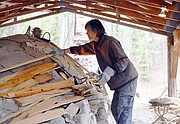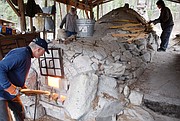Potters create art with ancient firing method
HEIDI DESCH | Hagadone News Network | UPDATED 5 years, 11 months AGO
Heidi Desch is features editor and covers Flathead County for the Daily Inter Lake. She previously served as managing editor of the Whitefish Pilot, spending 10 years at the newspaper and earning honors as best weekly newspaper in Montana. She was a reporter for the Hungry Horse News and has served as interim editor for The Western News and Bigfork Eagle. She is a graduate of the University of Montana. She can be reached at hdesch@dailyinterlake.com or 406-758-4421. | April 30, 2019 4:33 PM
A group of potters recently came together here to use the ancient science of a wood-fired kiln to create art.
Three Japanese potters joined Tom Gilfillan at the Whitefish Pottery Studios on the Stillwater River, and a host of other potters and volunteers, to fire pottery in a wood-fired tunnel kiln known as an anagama.
Gilfillan, says anagama kilns come in different sizes and can take from two days to three weeks to fire. The one on his property has been fired from three to five days in length, and only roughly 15 times total.
“They can all have a different look, but they all require a community to fire,” he said. “They all bring potters together.”
The three visiting potters Fuminori Deguchi, Kazutoshi Yamaguchi and Kazuyo Taguchi are presenting their work in the “Three Styles of Japan” exhibition at Whitefish Pottery and Stillwater Gallery during the first Whitefish Gallery Nights of the season on Thursday, May 2.
This is Deguchi’s third time visiting Whitefish. Deguchi and Gilfillan originally met through Mako Sakaguchi with the State of Montana and Japan Trade Office in 2002. In 2003, Gilfillan was fortunate enough to visit and work in Deguchi’s studio in Kumamoto, Japan, his hometown. Then in 2004, Deguchi was able to visit and work in the Whitefish Pottery Studios to fire the anagama kiln.
All three potter’s have been hard at work making pottery and firing the wood kiln here.
During the recent firing, somewhere between 1,700 and 1,900 pieces were loaded into the kiln over a period of about 30 hours. Firing of the kiln lasted about five days as potters and other volunteers worked rotating shifts to keep the kiln firing using up to five cords of wood.
An anagama kiln is an ancient type of pottery kiln brought to Japan from China via Korea in the 5th century.
The term anagama describes single-chamber kilns built in a sloping tunnel shape.
A small fire is lit in the mouth of the kiln and the fire is constantly fed slowing increasing the temperature to 2,400 degrees Fahrenheit.
The flame travels the entire length of the kiln, about 50 feet. The flames maneuver around the pottery inside creating what’s known as flashing and fly-ash is carried by the flames to settle on the pottery where it melts creating a natural ash glaze.
“No two firings are alike,” Gilfillan explains. “You never know exactly what they will look like.”
MORE FRONT-PAGE-SLIDER STORIES
ARTICLES BY HEIDI DESCH

Prerelease center lawsuit settlement goes before county board
A settlement agreement in a lawsuit filed by the state against Flathead County for rejecting the opening of prerelease center in Evergreen will be considered by a county board.

Hintze, noted Flathead Valley journalist, dies at 68
On more than one occasion, journalist Lynnette Hintze took notes by flashlight from a windowless newsroom at the Daily Inter Lake.

Former Inter Lake journalist Lynnette Hintze remembered for commitment to telling community’s stories
On more than one occasion, journalist Lynnette Hintze took notes by flashlight from a windowless newsroom at the Daily Inter Lake.








